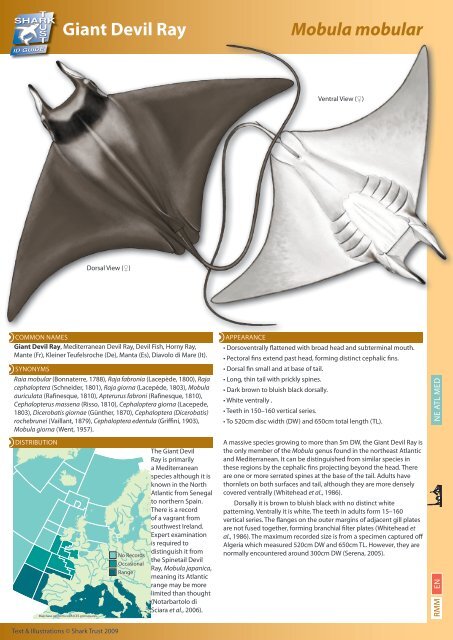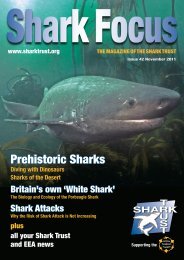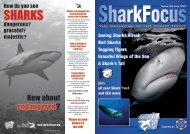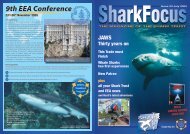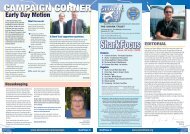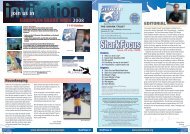Giant Devil Ray Mobula mobular - The Shark Trust
Giant Devil Ray Mobula mobular - The Shark Trust
Giant Devil Ray Mobula mobular - The Shark Trust
Create successful ePaper yourself
Turn your PDF publications into a flip-book with our unique Google optimized e-Paper software.
<strong>Giant</strong> <strong>Devil</strong> <strong>Ray</strong> <strong>Mobula</strong> <strong>mobular</strong><br />
COMMON NAMES APPEARANCE<br />
<strong>Giant</strong> <strong>Devil</strong> <strong>Ray</strong>, Mediterranean <strong>Devil</strong> <strong>Ray</strong>, <strong>Devil</strong> Fish, Horny <strong>Ray</strong>, • Dorsoventrally flattened with broad head and subterminal mouth.<br />
Mante (Fr), Kleiner Teufelsroche (De), Manta (Es), Diavolo di Mare (It).<br />
• Pectoral fins extend past head, forming distinct cephalic fins.<br />
SYNONYMS<br />
Raia <strong>mobular</strong> (Bonnaterre, 1788), Raja fabronia (Lacepède, 1800), Raja<br />
cephaloptera (Schneider, 1801), Raja giorna (Lacepède, 1803), <strong>Mobula</strong><br />
auriculata (Rafinesque, 1810), Apterurus fabroni (Rafinesque, 1810),<br />
Cephalopterus massena (Risso, 1810), Cephaloptera giorna (Lacepede,<br />
1803), Dicerobatis giornae (Günther, 1870), Cephaloptera (Dicerobatis)<br />
rochebrunei (Vaillant, 1879), Cephaloptera edentula (Griffini, 1903),<br />
<strong>Mobula</strong> giorna (Went, 1957).<br />
DISTRIBUTION<br />
Map base conforms with ICES grid squares.<br />
Dorsal View (♀)<br />
Text & Illustrations © <strong>Shark</strong> <strong>Trust</strong> 2009<br />
No Records<br />
Occasional<br />
Range<br />
<strong>The</strong> <strong>Giant</strong> <strong>Devil</strong><br />
<strong>Ray</strong> is primarily<br />
a Mediterranean<br />
species although it is<br />
known in the North<br />
Atlantic from Senegal<br />
to northern Spain.<br />
<strong>The</strong>re is a record<br />
of a vagrant from<br />
southwest Ireland.<br />
Expert examination<br />
is required to<br />
distinguish it from<br />
the Spinetail <strong>Devil</strong><br />
<strong>Ray</strong>, <strong>Mobula</strong> japanica,<br />
meaning its Atlantic<br />
range may be more<br />
limited than thought<br />
(Notarbartolo di<br />
Sciara et al., 2006).<br />
• Dorsal fin small and at base of tail.<br />
• Long, thin tail with prickly spines.<br />
• Dark brown to bluish black dorsally.<br />
• White ventrally .<br />
• Teeth in 150–160 vertical series.<br />
Ventral View (♀)<br />
• To 520cm disc width (DW) and 650cm total length (TL).<br />
A massive species growing to more than 5m DW, the <strong>Giant</strong> <strong>Devil</strong> <strong>Ray</strong> is<br />
the only member of the <strong>Mobula</strong> genus found in the northeast Atlantic<br />
and Mediterranean. It can be distinguished from similar species in<br />
these regions by the cephalic fins projecting beyond the head. <strong>The</strong>re<br />
are one or more serrated spines at the base of the tail. Adults have<br />
thornlets on both surfaces and tail, although they are more densely<br />
covered ventrally (Whitehead et al., 1986).<br />
Dorsally it is brown to bluish black with no distinct white<br />
patterning. Ventrally it is white. <strong>The</strong> teeth in adults form 15–160<br />
vertical series. <strong>The</strong> flanges on the outer margins of adjacent gill plates<br />
are not fused together, forming branchial filter plates (Whitehead et<br />
al., 1986). <strong>The</strong> maximum recorded size is from a specimen captured off<br />
Algeria which measured 520cm DW and 650cm TL. However, they are<br />
normally encountered around 300cm DW (Serena, 2005).<br />
RMM EN<br />
NE ATL MED
SIMILAR SPECIES<br />
Myliobatis aquila, Common Eagle <strong>Ray</strong><br />
Pteromylaeus bovinus, Bull <strong>Ray</strong><br />
Rhinoptera marginata, Lusitanian Cownose <strong>Ray</strong><br />
Myliobatis aquila,<br />
Common Eagle <strong>Ray</strong><br />
Rhinoptera marginata,<br />
Lusitanian Cownose <strong>Ray</strong><br />
(Not to scale)<br />
Supported by:<br />
Text & Illustrations © <strong>Shark</strong> <strong>Trust</strong> 2009<br />
<strong>Giant</strong> <strong>Devil</strong> <strong>Ray</strong><br />
<strong>Mobula</strong> <strong>mobular</strong>,<br />
<strong>Giant</strong> <strong>Devil</strong> <strong>Ray</strong><br />
Pteromylaeus bovinus,<br />
Bull <strong>Ray</strong>
TEETH<br />
<strong>Giant</strong> <strong>Devil</strong> <strong>Ray</strong> <strong>Mobula</strong> <strong>mobular</strong><br />
Sharp cusped teeth, 54–60 rows in<br />
the upper jaw (Farias et al., 2005.<br />
Clark, 1926).<br />
ECOLOGY & BIOLOGY<br />
HABITAT<br />
<strong>The</strong> <strong>Giant</strong> <strong>Devil</strong> <strong>Ray</strong> is an epipelagic species primarily found in<br />
offshore deepwater over continental shelves. It can be found from<br />
the surface to a depth of several thousand metres (Notarbartolo di<br />
Sciara et al., 2006). Often seen in groups of two or more. It may make<br />
long migrations across its range, the reasons for which are as yet<br />
unknown (Serena, 2005).<br />
DIET<br />
<strong>The</strong> <strong>Giant</strong> <strong>Devil</strong> <strong>Ray</strong> is adapted to feed on planktonic crustaceans<br />
and small schooling fishes with the gills forming branchial filter<br />
plates. In the Mediterranean Sea, the most important prey item is<br />
the euphasiid shrimp, Meganyctiphanes norveggica (Notarbartolo di<br />
Sciara et al., 2006).<br />
REPRODUCTION<br />
An aplacental viviparous species, <strong>Giant</strong> <strong>Devil</strong> <strong>Ray</strong> embryos receive<br />
nourishment from uterine milk (histotroph) secretions. <strong>The</strong> females<br />
give birth to a single pup after a gestation period of 25 months. <strong>The</strong><br />
largest term embryo yet recorded had a disc width of 165.9cm and<br />
weighed 35kg (Notarbartolo di Sciara et al., 1988).<br />
Text & Illustrations © <strong>Shark</strong> <strong>Trust</strong> 2009<br />
LATERAL VIEW OF HEAD<br />
<strong>Mobula</strong> <strong>mobular</strong>,<br />
<strong>Giant</strong> <strong>Devil</strong> <strong>Ray</strong><br />
Myliobatis aquila,<br />
Common Eagle <strong>Ray</strong><br />
Pteromylaeus bovinus,<br />
Bull <strong>Ray</strong><br />
Rhinoptera marginata,<br />
Lusitanian Cownose <strong>Ray</strong>
Supported by:<br />
COMMERCIAL IMPORTANCE<br />
<strong>The</strong> <strong>Giant</strong> <strong>Devil</strong> <strong>Ray</strong> is not targeted but is taken by longlines, pelagic<br />
driftnets, purse seines, trawls and fixed tuna traps. This bycatch is<br />
generally discarded (Notarbartolo di Sciara et al., 2006).<br />
THREATS, CONSERVATION, LEGISLATION<br />
Although there is no directed fishery for the <strong>Giant</strong> <strong>Devil</strong> <strong>Ray</strong>,<br />
incidental catch and mortality rates are high. It was regularly<br />
captured by pelagic driftnets targeting swordfish in the<br />
Mediterranean but the use of these was banned by the EU in 2002<br />
(Notarbartolo di Sciara et al., 2006). Illegal driftnet fishing is still a<br />
serious problem however (EJF, 2007). It is also taken by longlines,<br />
purse seines, trawls and fixed tuna traps. It is generally discarded<br />
when caught. Due to its relatively limited geographic range,<br />
habitat destruction could also be a significant threat to the species,<br />
particularly considering the poor state of many Mediterranean<br />
ecosystems. Its epipelagic habitat makes it particularly vulnerable<br />
to oil spills and heavy maritime traffic (Notarbartolo di Sciara et al.,<br />
2006).<br />
<strong>The</strong> <strong>Giant</strong> <strong>Devil</strong> <strong>Ray</strong> is included in the Annex II list of endangered<br />
or threatened species to the Protocol concerning Special Protected<br />
Areas and Biological Diversity in the Mediterranean of the Barcelona<br />
Convention, which came into force in 2001 (Notarbartolo di Sciara<br />
et al., 2006). <strong>The</strong> Mediterranean wide ban on the use of pelagic<br />
driftnets should have removed one of the most significant threats<br />
to the species but it has proved difficult to enforce and unregulated<br />
fishing has continued on a large scale (EJF, 2007).<br />
Text & Illustrations © <strong>Shark</strong> <strong>Trust</strong> 2009<br />
IUCN RED LIST ASSESSMENT<br />
Endangered (2006).<br />
HANDLING AND THORN ARRANGEMENT<br />
• Handle with care.<br />
<strong>Giant</strong> <strong>Devil</strong> <strong>Ray</strong><br />
• Extremely large with venomous spine at base of tail.
REFERENCES<br />
<strong>Giant</strong> <strong>Devil</strong> <strong>Ray</strong> <strong>Mobula</strong> <strong>mobular</strong><br />
EJF. 2007. Illegal Driftnetting in the Mediterranean. Environmental<br />
Justice Foundation. London, UK.<br />
MCAULIFFE, J. A., ITANO, D. G., ARCENEAUX, S. 2007. Photographic<br />
Identification Guide for Billfish, <strong>Shark</strong>s, <strong>Ray</strong>s, Tuna-like and Non<br />
Tuna Finfish Taken in WCPO Pelagic Longline Fisheries (V1).<br />
Western and Central Pacific Fisheries Commission. Honolulu,<br />
USA.<br />
NOTARBARTOLO DI SCIARA, G., SERENA, F., MANCUSI, C. 2006.<br />
<strong>Mobula</strong> <strong>mobular</strong>. In: IUCN 2008. 2008 IUCN Red List of<br />
Threatened Species. www.iucnredlist.org.<br />
NOTARBARTOLO DI SCIARA, G., SERENA, F. 1988. Term Embryo<br />
of <strong>Mobula</strong> <strong>mobular</strong> (Bonnaterre, 1788) from the Northern<br />
Tyrrhenian Sea. Atti Soc. ital. Sci. nat. Museo civ. Stor. nat. Milano,<br />
129 (4): 396–400.<br />
SERENA, F. 2005. Field Identification Guide to the <strong>Shark</strong>s and <strong>Ray</strong>s<br />
of the Mediterranean and Black Sea. FAO. Rome, Italy.<br />
WHITEHEAD, P. J. P., BAUCHOT, M. L., HUREAU, J. C., NIELSEN, J.,<br />
TORTONESE, E. (Eds.). 1986. Fishes of the Northeast Atlantic and<br />
Mediterranean. UNESCO. Paris, France.<br />
Text & Illustrations © <strong>Shark</strong> <strong>Trust</strong> 2009<br />
Text: Richard Hurst.<br />
Illustrations: Marc Dando.<br />
Citation<br />
<strong>Shark</strong> <strong>Trust</strong>; 2009. An Illustrated Compendium of <strong>Shark</strong>s, Skates, <strong>Ray</strong>s<br />
and Chimaera. Chapter 1: <strong>The</strong> British Isles. Part 1: Skates and <strong>Ray</strong>s.<br />
Any ammendments or corrections, please contact:<br />
<strong>The</strong> <strong>Shark</strong> <strong>Trust</strong><br />
4 Creykes Court, <strong>The</strong> Millfields<br />
Plymouth, Devon PL1 3JB<br />
Tel: 01752 672008/672020<br />
Email: enquiries@sharktrust.org<br />
For more ID materials visit www.sharktrust.org/ID.<br />
Registered Company No. 3396164.<br />
Registered Charity No. 1064185


